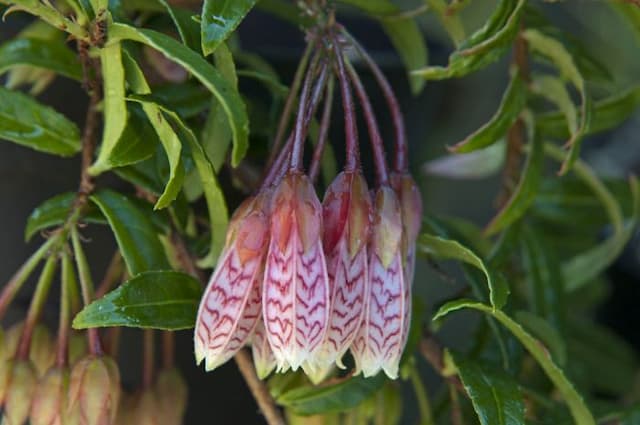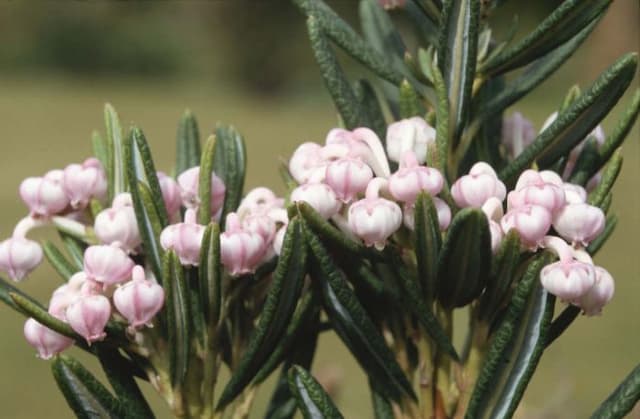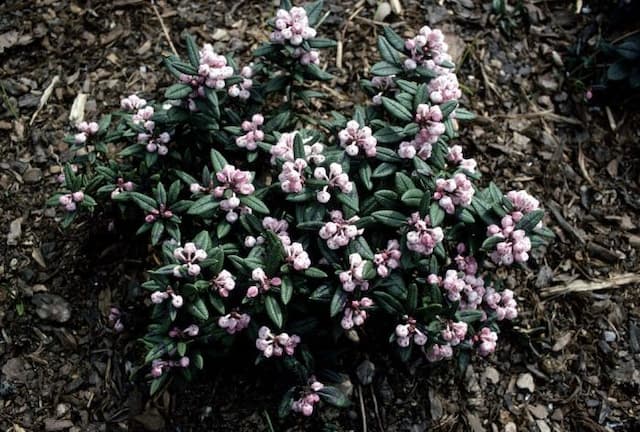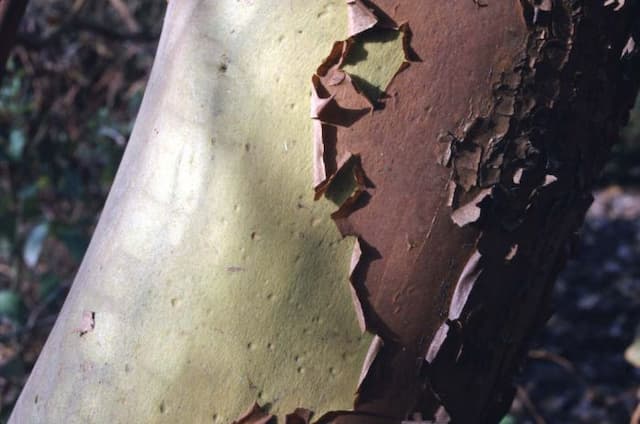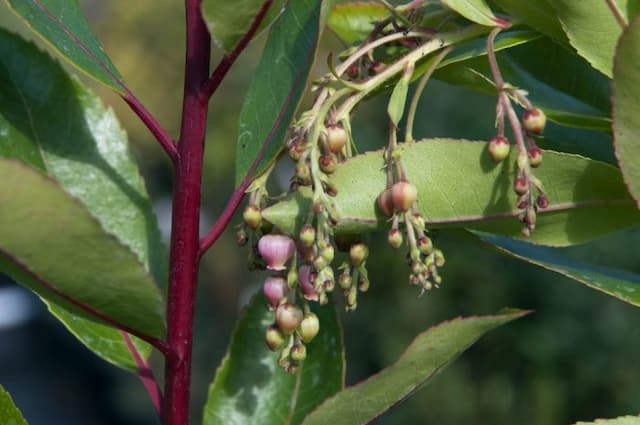Heather Calluna vulgaris 'Tib' (d)

ABOUT
Calluna vulgaris 'Tib' (d), commonly known as Heather, is a plant characterized by its small, scale-like evergreen leaves that cloak the plant's numerous branching stems, presenting a dense, fine-textured appearance. The foliage can vary in color from bright green to golden hues, depending on the variety and the season. This Heather is distinguished by its colorful flowers, which are typically small, bell-shaped, and borne in terminal clusters atop slender stems. The flowers may range from white, pink, purple, or red, often offering a vibrant display that adds a splash of color to the landscape. The blossoms are particularly attractive to bees and other pollinators, adding to the ecosystem value of the plant. Beyond its floral appeal, Heather is noted for its hardiness and the way in which it forms a low-growing, mat-like ground cover, creating a carpet of greenery that can be very effective in controlling soil erosion. Its needles and flowers together contribute to a fine texture that can provide visual interest throughout multiple seasons, making it a versatile choice for various garden applications. Heather is appreciated for its rustic charm and its ability to thrive in a variety of soil types, although it particularly favors well-drained, acidic soils. With proper care, it can become a long-lasting feature in a garden, contributing to a classic or wild landscape aesthetic.
About this plant
 Names
NamesFamily
Ericaceae.
Synonyms
Scotch Heather, Ling Heather, Scottish Heather, Heather.
Common names
Calluna vulgaris.
 Toxicity
ToxicityTo humans
Heather is generally not considered toxic to humans. There are no well-known toxic effects or symptoms of poisoning associated with ingesting this plant. However, as with any non-food plant, individual allergies or sensitivities can occur, so it's advisable to avoid ingestion.
To pets
Heather is not known to be toxic to pets. It is not listed among commonly recognized poisonous plants for dogs, cats, or other animals. As with humans, pets can sometimes have individual sensitivities or allergic reactions, but there are no widespread reports of toxic effects from pets ingesting this plant.
 Characteristics
CharacteristicsLife cycle
Perennials
Foliage type
Evergreen
Color of leaves
Green
Flower color
Varies
Height
1-2 feet (30-60 cm)
Spread
1-2 feet (30-60 cm)
Plant type
Shrub
Hardiness zones
4-8
Native area
Europe
Benefits
 General Benefits
General Benefits- Ornamental Value: Adds vibrant color and texture to garden landscapes, especially during flowering seasons.
- Low Maintenance: Requires minimal care once established, making it suitable for busy gardeners or those looking for low-effort plants.
- Drought Tolerant: Adapts well to dry conditions, making it ideal for water-conservation landscapes or regions with water restrictions.
- Pest Resistance: Naturally resistant to many pests, reducing the need for chemical treatments.
- Wildlife Attraction: Flowers attract bees, butterflies, and other pollinators, supporting local ecosystems.
- Soil Erosion Control: Dense growth habit can help stabilize soil and prevent erosion on slopes or banks.
- Winter Interest: Retains structure and color in the winter, providing visual interest in otherwise bare gardens.
- Long Blooming: Produces flowers for an extended period, often from mid-summer through fall.
- Hardiness: Can survive in a range of climates, withstanding cold temperatures in certain hardiness zones.
 Medical Properties
Medical Properties- This plant is not used for medical purposes.
 Air-purifying Qualities
Air-purifying QualitiesThis plant is not specifically known for air purifying qualities.
 Other Uses
Other Uses- Heather 'Tib' can be used as a natural dye, providing shades of yellow, green, or orange, depending on the mordant used.
- When dried, the stems of Heather can be woven into baskets, providing both strength and an interesting texture.
- Heather is sometimes incorporated into thatched roofs in some traditional Scottish homes as it is durable and weather-resistant.
- The flowers of Heather are used in the production of a unique honey with a characteristic strong taste and floral aroma.
- Farmers have traditionally used Heather as bedding for livestock, especially sheep, as it is soft and insulating.
- In some cultures, Heather is used to craft small good luck charms or amulets believed to bring protection and good fortune.
- Heather twigs can be tied together to create besom brooms, which are used for sweeping as well as in various traditional rituals.
- The plant can serve as a food source for certain species of livestock, like deer, during the winter months when other food is scarce.
- Heather can be used in the brewing of certain traditional beers or ales, imparting a subtle flavor and aroma.
- During historical times, Heather has been used as a fuel source for fires in places where wood was scarce.
Interesting Facts
 Feng Shui
Feng ShuiThe plant Heather is not used in Feng Shui practice.
 Zodiac Sign Compitability
Zodiac Sign CompitabilityThe plant Heather is not used in astrology practice.
 Plant Symbolism
Plant Symbolism- Protection: Calluna vulgaris, commonly known as heather, has been traditionally associated with protection. In ancient times, people believed that heather had protective powers and would use it to create charms to guard against evil and bad luck.
- Good Fortune: Heather is also often connected with good luck. It is considered fortuitous to include heather in bridal bouquets or to give it as a gift, symbolizing the wish that good fortune befalls the recipient.
- Admiration: Heather's hardiness and ability to grow in challenging conditions are admired traits, symbolizing respect and admiration for someone's perseverance and strength.
- Solitude: The plant's growth in barren areas can symbolize solitude or self-sufficiency, representing a person's ability to thrive even in isolation or under difficult circumstances.
- Beauty: With its delicate flowers, heather is frequently associated with beauty, both in the aesthetic sense and the inner beauty of a person's character.
 Water
WaterHeather plants like the Calluna vulgaris 'Tib' require consistent moisture, but they do not like to be waterlogged. Water the plant deeply to encourage a strong root system, providing about 1 gallon of water per plant per week during the growing season. Adjust the frequency to account for rainfall, and reduce watering during the winter months when the plant is dormant. It's important to ensure that the soil is well-draining to prevent root rot. During hot, dry periods, you may need to water heathers twice a week to maintain the desired moisture level.
 Light
LightHeather, including the variety Calluna vulgaris 'Tib', thrives in full sunlight to partial shade. The ideal spot for planting heather is a location that receives at least 6 hours of direct sunlight daily. These plants can also tolerate light shade, but flowering may be reduced in less than optimal light conditions.
 Temperature
TemperatureHeathers such as the Calluna vulgaris 'Tib' are cold-hardy plants, capable of surviving winter temperatures as low as 14 degrees Fahrenheit. However, they grow best in regions where summer temperatures do not exceed 75 degrees Fahrenheit, which provides an ideal temperature range for robust growth. They can withstand occasional extremes, but prolonged heat or cold outside of their tolerance levels may damage or stress the plants.
 Pruning
PruningPrune heather, specifically Calluna vulgaris 'Tib', to maintain its compact shape and encourage bushy growth. Pruning is best done immediately after flowering in late summer or early fall. Removing the spent flowers and about an inch of leafy growth will prevent the plant from becoming leggy. Regular light pruning each year keeps the plant rejuvenated and encourages healthy new growth.
 Cleaning
CleaningAs needed
 Soil
SoilHeather (Calluna vulgaris 'Tib') thrives best in well-draining, acidic soil with a pH of 4.5 to 5.5. A good soil mix for heather consists of equal parts peat moss, sand, and pine bark to ensure proper acidity and drainage.
 Repotting
RepottingHeather should be repotted every 3 to 4 years or when it becomes root-bound. Use a similar acidic soil mix during repotting to maintain optimal growing conditions.
 Humidity & Misting
Humidity & MistingHeather prefers moderate humidity but is quite adaptable. Aim to maintain humidity levels around 40-60% for optimal growth.
 Suitable locations
Suitable locationsIndoor
Place in bright, indirect light with acidic soil.
Outdoor
Full sun to partial shade, acidic soil, well-drained location.
Hardiness zone
4-6 USDA
 Life cycle
Life cycleCalluna vulgaris 'Tib', commonly known as Heather, begins its life cycle as a seed that germinates in spring to early summer after experiencing winter stratification. The seedling establishes itself, forming a small shrub with dense leafy growth, which can last many years. Vegetative growth continues through spring and summer, with the plant putting out numerous small, needle-like leaves. In late summer to autumn, Heather blooms, producing small, bell-shaped flowers that attract bees and other pollinators, which are essential for cross-pollination and seed production. Once pollinated, the flowers develop into seed capsules which remain on the plant through winter, releasing seeds the following spring. Heather plants can live up to 30-40 years, forming dense mats that can dominate landscapes, and they may also reproduce vegetatively by layering where the branches touch the ground and root.
 Propogation
PropogationPropogation time
Late summer
The most popular method of propagating Calluna vulgaris 'Tib', commonly known as Heather, is through semi-hardwood cuttings. This technique is typically done in late summer. Cuttings are taken from the current year's growth that has begun to harden but is not yet fully woody. Shoots of about 3 to 5 inches (approximately 7.5 to 13 centimeters) long are snipped just below a node, and the lower leaves are removed. The cut end is then dipped in rooting hormone to encourage root development and inserted into a well-draining rooting medium. The cuttings are then kept in a sheltered location with high humidity and indirect light until roots have established, after which they can be potted on or planted out.
